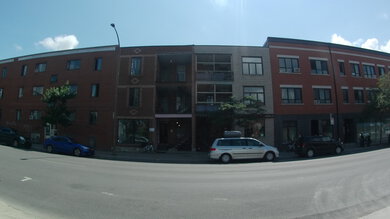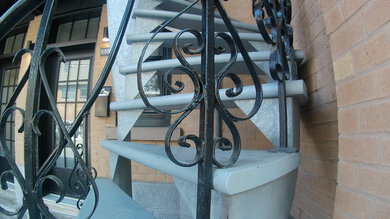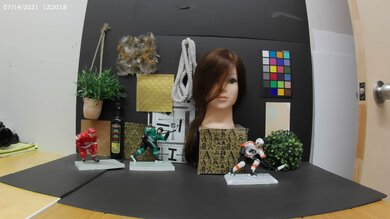The AKASO Brave 7 LE is a compact action camera that represents an alternative to models in the GoPro lineup. Like most action cams, its compact body is incredibly portable, and you can mount it on many action camera mounts, rigs, or helmets. It has dual screens, so you can monitor yourself on the front-facing screen when self-recording. It can shoot at up to 120 fps in FHD to capture fast action or generate slow-motion footage, although it can't record at 24 fps for those who prefer to shoot more cinematic-looking video. Unfortunately, it can also only shoot at 30 fps in 4k. It has decent image stabilization, but it's not available when shooting at 120 fps. Finally, its overall video quality is poor, with video that looks noisy and lacks sharpness.
Our Verdict
The AKASO Brave 7 LE is a poor choice for travel photography if image quality is a priority. While it's very portable to take with you wherever you travel, it's not intended for handheld use. It can take photos, but the perceived image quality may appear inferior compared to a dedicated stills camera, and the wide-angle lens creates a fisheye effect that can be distracting. It lacks an autofocus feature, but the fixed aperture lens has a really deep depth of field, so everything stays in focus. However, it gives you less flexibility to compose different shots. On the upside, it has great battery life and feels well-built, with a protective case that gives it added ruggedness and even greater waterproofing. That said, we don't currently test ruggedness or waterproofing.
- Incredibly portable.
- Feels well-built.
- Good battery life.
- No autofocus.
- Fisheye effect.
- Perceived image quality is lacking.
- Can't control shutter speed or aperture.
The AKASO Brave 7 LE isn't really intended for photography, though it can capture landscape images in a pinch while you're adventuring, like on a hike or rock climb. That said, images won't have the dynamic range or general image quality of a dedicated still camera.
The AKASO Brave 7 LE isn't intended for photography, though it can be convenient if you want to capture quick snapshots from within the action. Still, its image quality is significantly lacking, especially compared to dedicated stills cameras.
The AKASO Brave 7 LE doesn't shoot in RAW format.
The AKASO Brave 7 LE is okay for vlogging. It has a front-facing screen that lets you monitor the image as you record when shooting in a selfie position. It also has decent overall video stabilization, especially when shooting in 4k and moving at a moderate pace. That said, it's limited to 30 fps when shooting in 4k. Video quality overall is poor, resulting in grainy video. However, it's incredibly portable, and you can mount it on a helmet or other rig for easy recording on the go.
- Front-facing screen helps you monitor yourself.
- Incredibly portable.
- Poor video quality.
- No autofocus.
The AKASO Brave 7 LE isn't good for studio video. It has poor video quality overall, and it's especially bad in more well-lit environments. The fixed narrow aperture lens ensures everything stays in focus, but there's no autofocus tracking, and it limits what kind of video you can produce. The wide-angle field of view also creates a fisheye effect that distorts the image. Finally, it lacks a microphone and headphone jack.
- Menu is easy to navigate with touchscreen or app.
- Poor video quality.
- No autofocus.
- Fisheye effect.
- No headphone or mic jacks.
The AKASO Brave 7 LE is adequate for action video. It's incredibly portable and comes with many mounting accessories in the box. It also comes with a built-in tripod mount. It's rated to be waterproof up to 1 m without its protective case and up to 131 ft with the case equipped, although we don't currently test this. Its frame rates are a bit limited, as it can't shoot at 24 fps or 240 fps in FHD, and it can only shoot at 30 fps in 4k. Video quality overall is poor, especially in more well-lit conditions. That said, it has a decent image stabilization feature that does a good job of reducing camera shake, but it, unfortunately, incurs a severe 1.6x crop.
- Waterproof.
- Comes with rugged protective case and other accessories.
- Front-facing screen helps you monitor yourself.
- Decent image stabilization.
- Frame rates are limited.
- Poor video quality.
- Image stabilization feature incurs a severe crop.
Changelog
- Updated Jan 29, 2024: Added text to the 'Raw Photo Performance' verdict box and updated the 'Landscape Photography' and 'Sport & Wildlife Photography' boxes to more accurately reflect the camera's inadequacy for these uses.
- Updated Jan 29, 2024: Converted to Test Bench 0.12.1.
- Updated Dec 21, 2022: Converted to Test Bench 0.12.
- Updated Dec 20, 2022: Converted to Test Bench 0.11.
Check Price
Differences Between Sizes And Variants
The AKASO Brave 7 LE only comes in one color variant: 'Black'. You can see our unit's label here.
If you come across another variant or your AKASO Brave 7 LE doesn't correspond to our review, let us know in the discussions, and we'll update the review.
Popular Camera Comparisons
The DJI Osmo Action is better overall than the AKASO Brave 7 LE, though both are highly portable and feature front-facing screens that are helpful for vlogging. Still, the DJI feels better built and offers more frame rate options, including 4k up to 60 fps and 1080p up to 240 fps, compared to 4k / 30 fps and 1080p up to 120 fps on the AKASO. The DJI also has a better stabilization feature and delivers better overall video quality.
Test Results

Note: With the protective case equipped, the camera is slightly less portable, measuring:
- Height: (7.7 cm)
- Width: (8.3 cm)
- Depth: (4.1 cm)
- Volume: (261 cm3)
- Weight: (0.19 kg)
- Weight With Lens: (0.19 kg)
- Materials feel robust, with a rubber finish around the sides for grip
- Inputs and outputs are covered by sturdy hinged doors, although some of them can be hard to open
- Buttons feel stiff
- Tripod mount is built-in, so you don't need an extra accessory
- Plastic cover on lens feels somewhat flimsy and may scratch easily
Note: The camera itself is advertised to have an IPX7 waterproof rating, meaning it's waterproof up to 1m for 30 minutes. AKASO also advertises it to be waterproof up to 131 feet with the protective case on. That said, we don't currently test this.
- It's intended to be mounted and used as an action camera, but it can also be used handheld to take photos/videos if desired
- Menu is easy to navigate and settings can be changed using either the touchscreen or companion app
- ISO can be adjusted but the aperture is fixed and shutter speed adjusts automatically
- Shutter can also be activated using the included remote control
- Buttons are hard to press
- Output and battery door are hard to open
Update 10/14/2021: Added additional information about the camera's second front-facing screen.
This camera has an additional screen on the front that can be used for Live View while recording and also displays information like shooting mode and remaining battery life.
- Menu is simple and easy to navigate using the touchscreen or companion app
- Can swipe up on the screen while shooting to access shortcut menu
- Holding down shutter button allows you to change the drive mode
- Menu can be a bit sluggish
- No guide mode to provide additional information about settings
Note: When recording for long periods, the camera records video files in sequential clips of 35 minutes each.
Note: This camera only has a single burst mode that can be set to take bursts of 3, 7, 15, or 30 images, but it consistently shoots at a speed of 1 fps.
Note: This camera doesn't shoot in RAW format.
Note: According to AKASO, the camera doesn't record sound when in its protective case. However, we tested the audio with the protective case on, and it can still record sound, though the audio is significantly muffled. You can hear the sample here.
Note: This camera doesn't have adjustable bit rate settings.
















